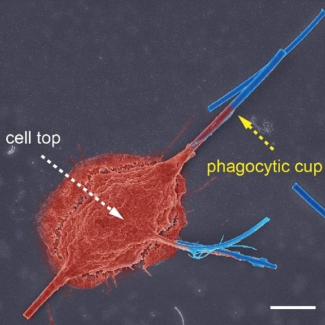
A molecular label: traceability for medical implants
A team of researchers at CNRS, Aix-Marseille Université and Université Paris 13 has demonstrated effective molecular labelling to unequivocally identify biomedical implants, even after a prolonged period inside the living being. These results were published in Angewandte Chemie International Edition on July 5, 2018.
Identification and traceability is extremely important for biomedical implants. Health scandals surrounding medical devices have shown that patients must be able to determine the origin of adulterated implants responsible for clinical complications. However, if the packaging is not stored, it is quite difficult to authenticate an implant, especially if it has remained in a body for several years.
In this context, teams from the CNRS Institut Charles Sadron, the Laboratoire de Recherche Vasculaire Translationnelle (Université Paris 13/INSERM/Université Paris Diderot) and the Institut de Chimie Radicalaire (CNRS/Aix-Marseille Université) have recently developed an innovative solution that can chemically “label” an implant at the molecular level.
The researchers have used polymers to do this. These are large molecules composed of two basic subunits whose linking connections form a code, similar to sequences of 0s and 1s in computing. By determining the mass of each polymer fragment using an analytical chemistry method called mass spectrometry, the molecule's “code” can be determined and decrypted in the same way as a bar code.
These molecular labels have been incorporated in tiny quantities in model implants, which were implanted into rats. After three months, the implants were extracted from the animals and analyzed. Mass spectrometry showed that the identification polymer could be decoded unambiguously.
These results are a major step forward for the field of traceability and preventing counterfeiting for healthcare materials. Mass spectrometry is already used in many healthcare facilities and analytical laboratories, so this identification method could easily be extended to other applications.

Encoded polymers have been incorporated into polyvinyl alcohol implants, which were implanted into rats. After an in vivo incubation period, the implants were removed. Mass spectrometry can identify the polymer that marks each implant.
Abiotic sequence-coded oligomers as efficient in vivo taggants for identification of implanted materials. D. Karamessini, T. Simon-Yarza, S. Poyer, E. Konishcheva, L. Charles, D. Letourneur and JF. Lutz. Angewandte Chemie International Edition, July 5, 2018.

